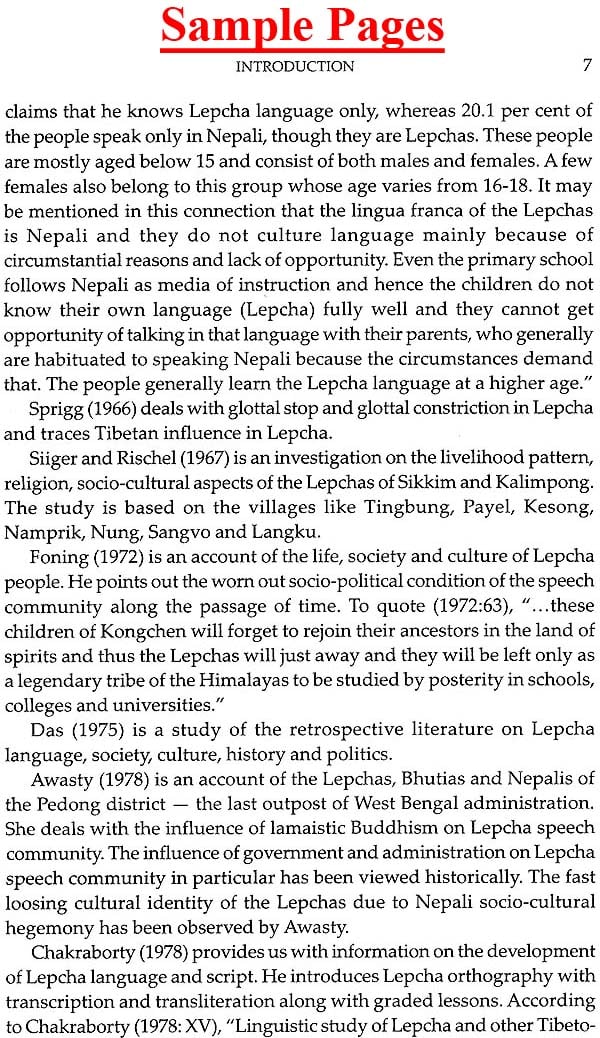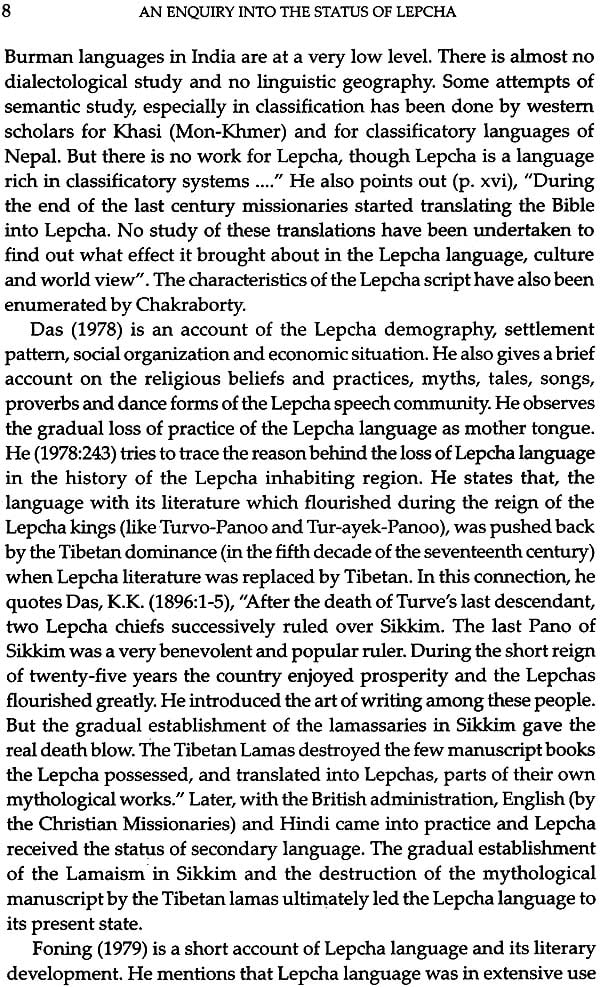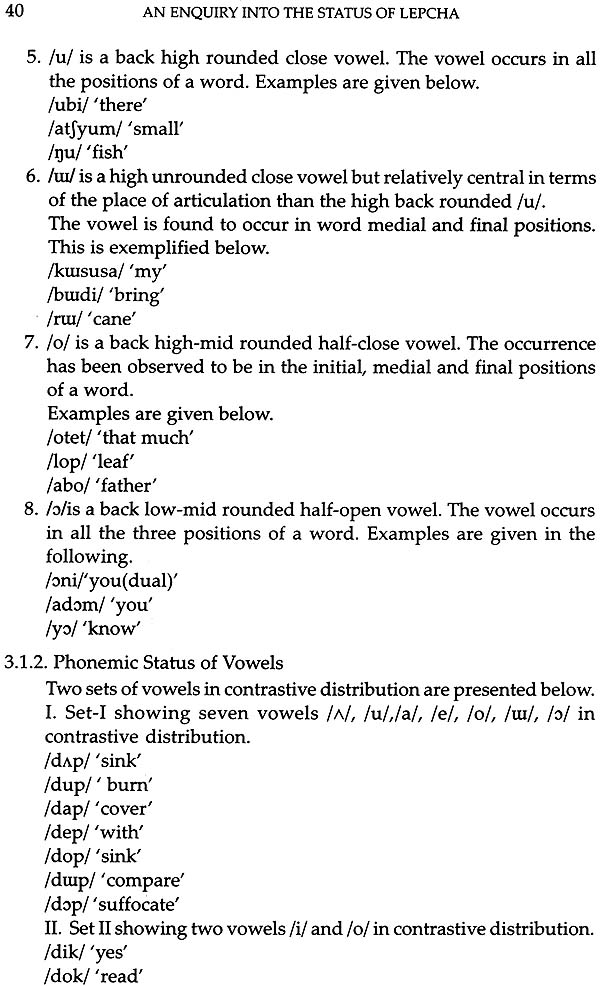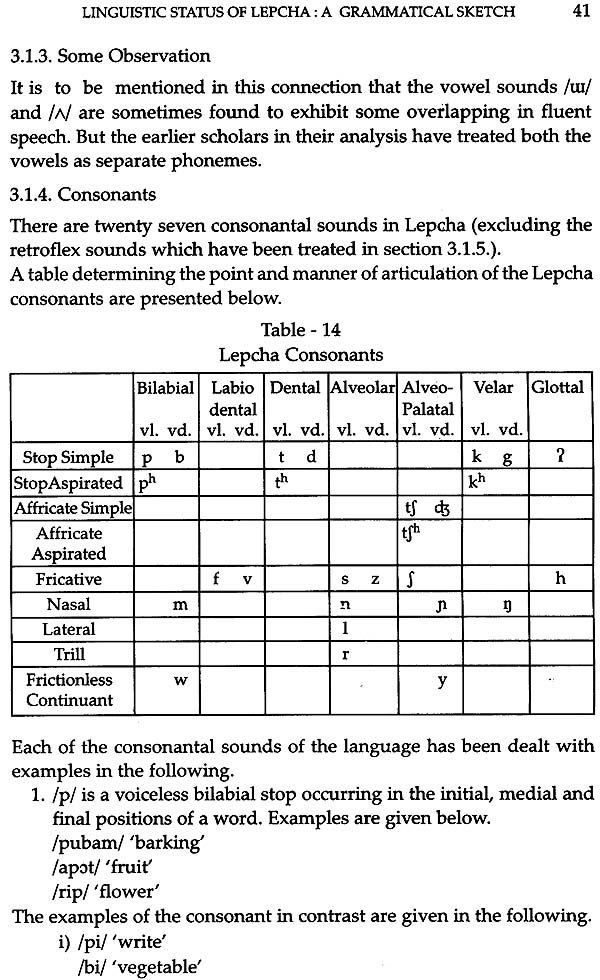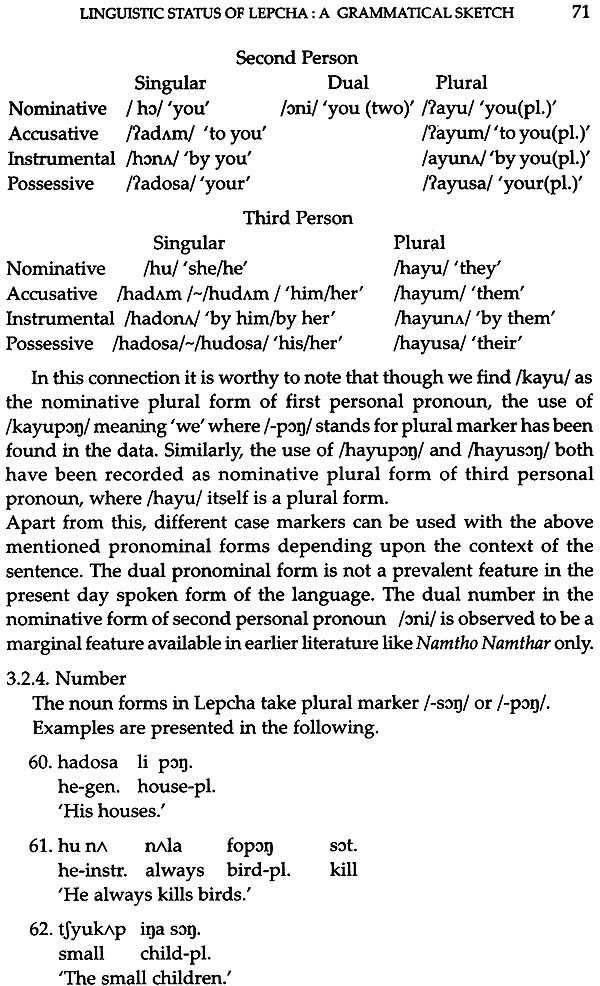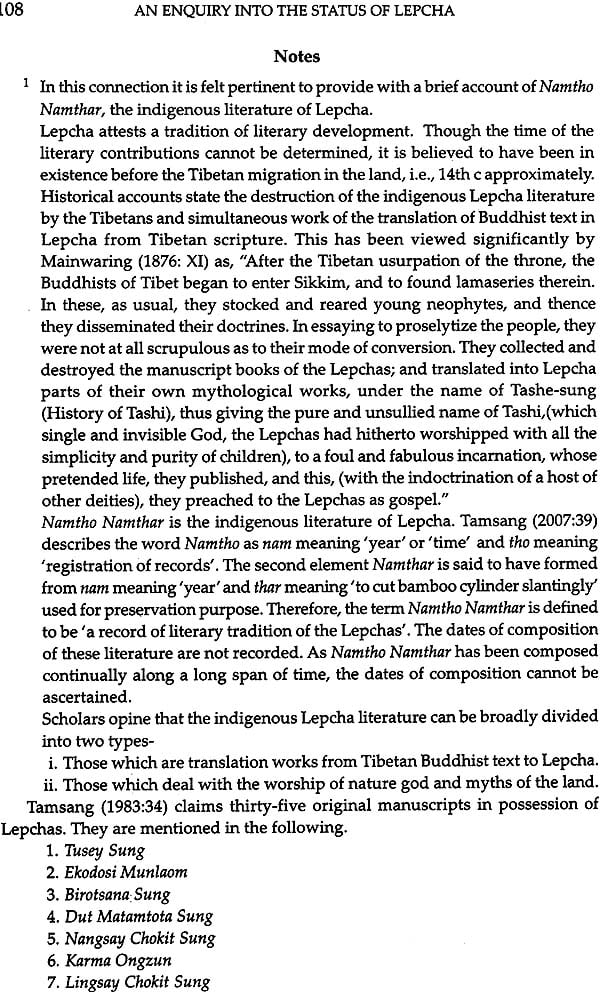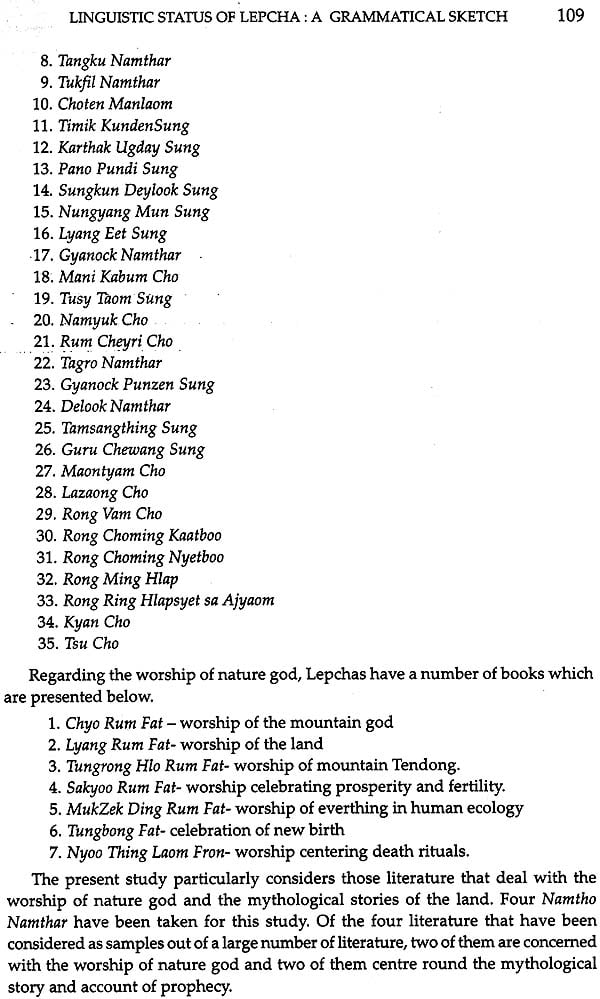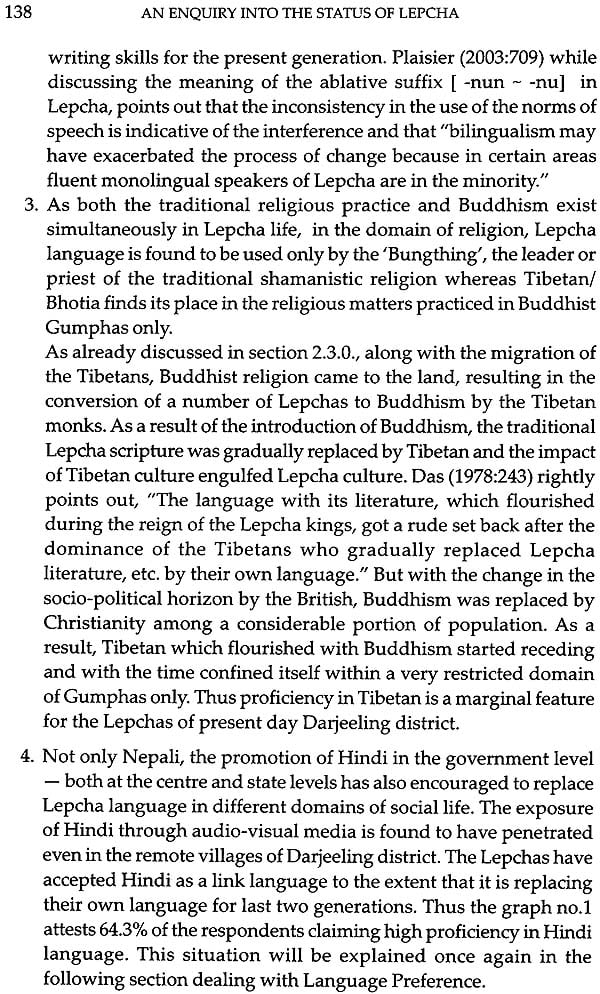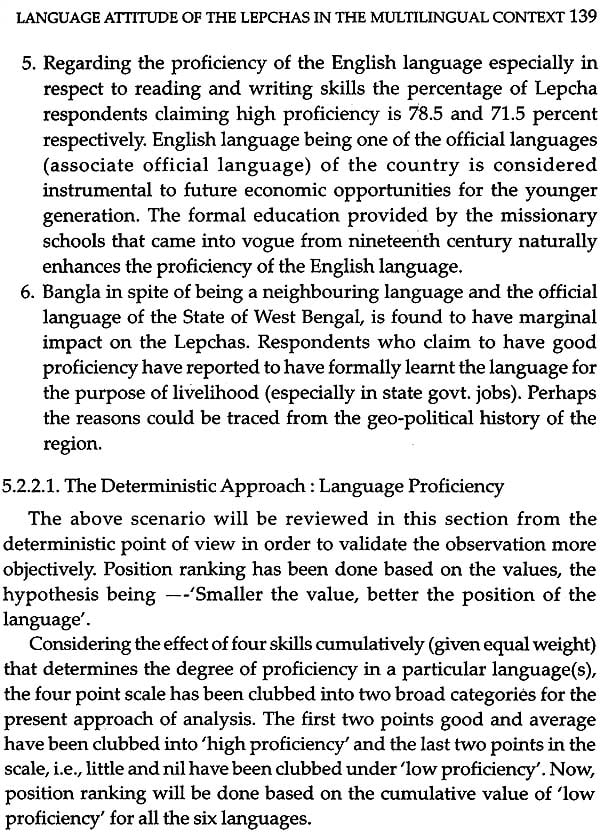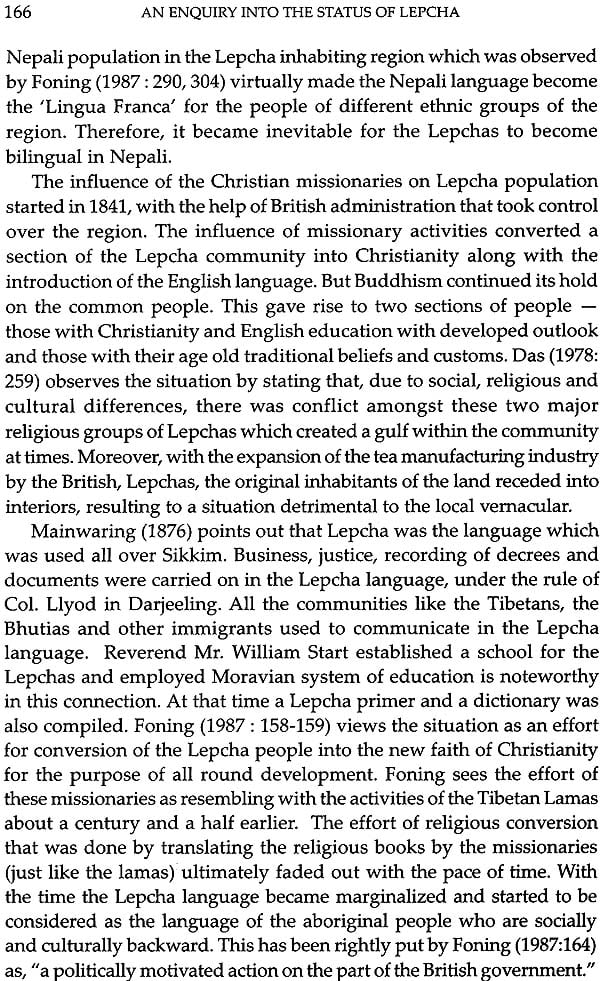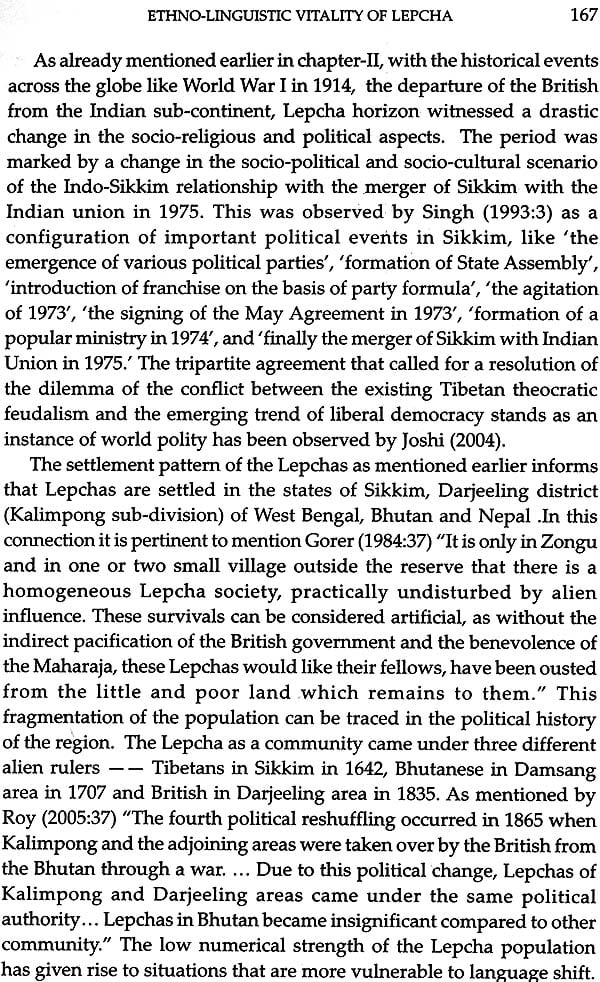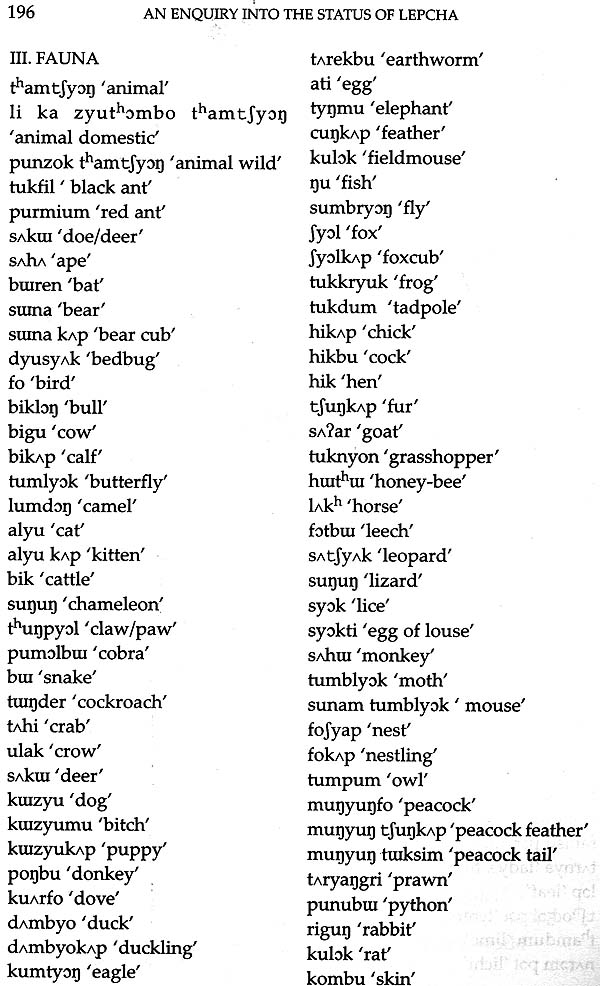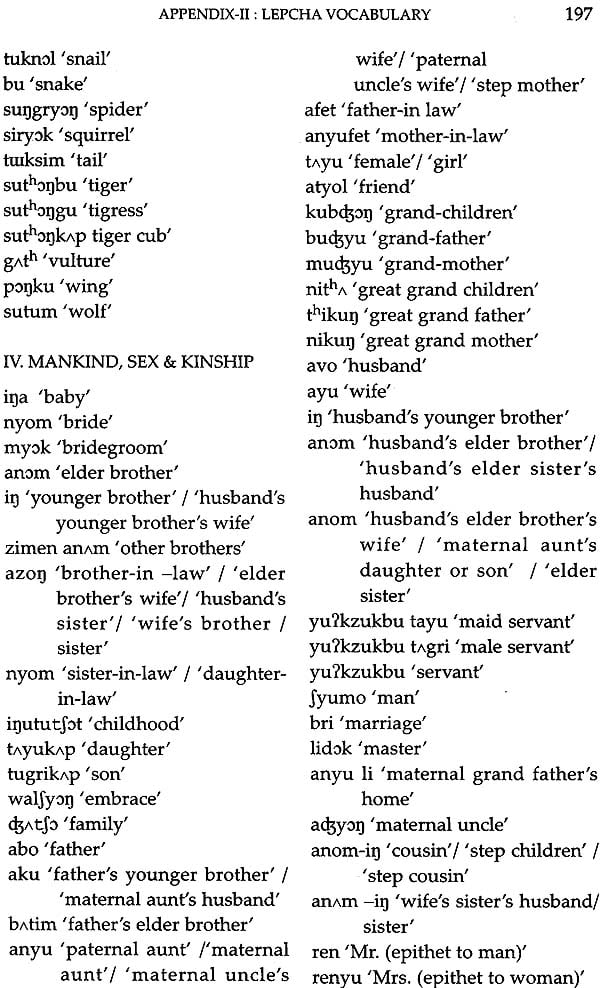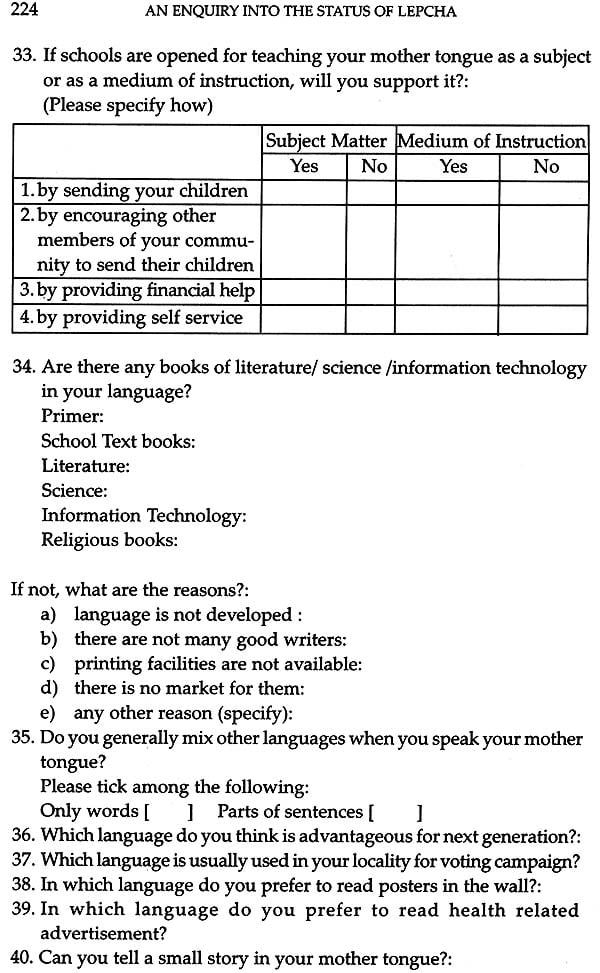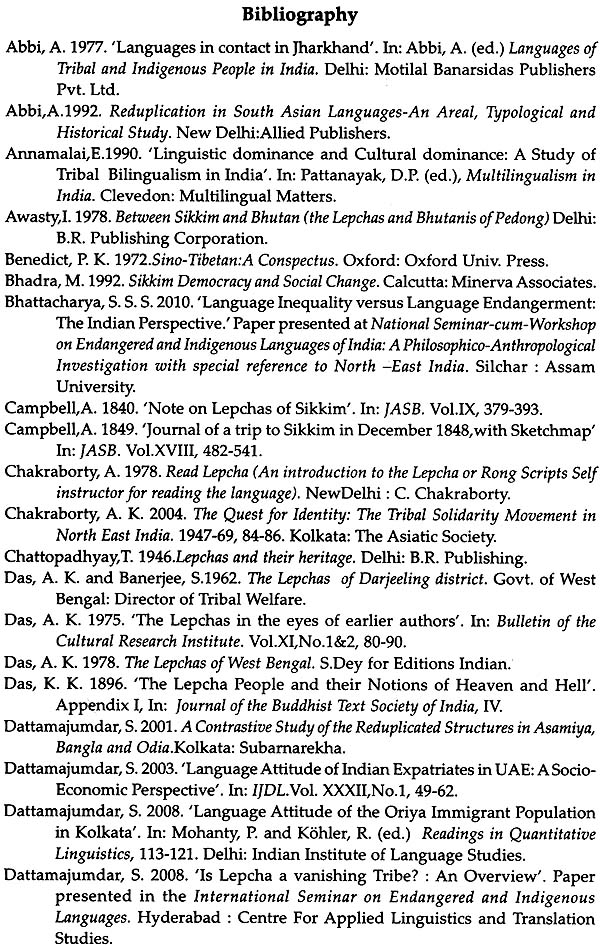
An Enquiry into The Status of Lepcha
Book Specification
| Item Code: | NAK216 |
| Author: | Satarupa Dattamajumdar |
| Publisher: | THE ASIATIC SOCIETY |
| Language: | English |
| Edition: | 2016 |
| ISBN: | 9789381574539 |
| Pages: | 347 |
| Cover: | Hardcover |
| Other Details | 9.5 inch X 6.5 inch |
| Weight | 570 gm |
Book Description
In the context of the current position of the languages of North-East India, where many languages are found to be marginalized, a detailed enquiry regarding the social dynamics of language maintenance and shift was felt essential especially in case of a tribal language like Lepcha. It has been studied by different scholars from different points of view starting from 1840 till date, a detailed enquiry regarding the status of the language was a desideratum. Therefore, keeping in view the socio- political situation of the Lepcha inhabiting areas like Dzongu valley of Sikkim and Darjeeling district of West Bengal, an enquiry into the status of Lepcha is attempted in this present treatise. The study on the status of the Lepcha language is carried out for understanding the situations of linguistic minority, the issue of language equality versus inequality, language development profile, the nature and extent of marginalization, language attitude and the ethno-linguistic vitality of the speech community. The implication of study in the context of language planning and development of the country is highlighted.
About the Author
Satarupa Dattamajumdar (Saha), did her M.A. and Ph.D. in Linguistics from University of Calcutta. She has been involved in research and teaching programmes of different premier institutes like Central Institute of Indian Languages, Mysore; Institute of Education for Women, Hastings House; Blind Boys' Adcademy, Ramakrishna Mission, Narendrapur; Indian Statistical Institute, Kolkata; The Asiatic Society, Kolkata; Indian Council of Social Science Research, New Delhi; Institute of Cybernetics Systems and Information Technology, Kolkata; Kolkata Society for Asian Studies; and Indian National Science Academy, New Delhi. Her area of research mainly concentrates on the linguistic situation of the speech communities of North-East India. She has contributed to the area of core linguistics, socio -linguistics, quantitative- linguistics, speech-pathology, ethno- linguistics and linguistic historiography by publishing books and research articles in national and international journals of repute.
The present monograph is the result of a field research in the broad field of Ethno-linguistics, undertaken by Dr. Satarupa Dattamajumdar as Research Fellow at the Asiatic Society. Keeping in tradition set by Buchanan, F. through the publications entitled 'A Comparative Vocabulary of Some of the Languages Spoken in the Burma Empire' published in Asiatick Researches in 1797; Leyden, J. 'On the Languages and Literature of the Indo-Chinese nations', Asiatick Researches in 1808; Hodgson, B. H. 'Comparative Vocabulary of the Several Languages or Dialects of the Eastern Sub-Himalayas, from the Kali or Ghogra to the Dhansri, with the Written and Spoken Tibetan for Comparison', Journal of The Asiatic Society of Bengal in 1847 and followed through the Dictionary of the Lushai Language by James Herbert Lorrain in 1940 as well as the National Seminar on North-East Languages and Literature held at the Asiatic Society, Kolkata during March 20-22, 2006; further re-vitalized through a Round Table Conference on North-East India organised at the Asiatic Society on 29.09.2008 under the chairmanship of late Professor Barun De, our young scholar Dr. Dattamajumdar had ventured to study the Status of Lepcha. Lepcha is a language belonging to the non-pronominalized group of the Himalayan languages under Tibeto-Burman sub-family. The essential emphasis of this scholar was to study comparatively the Lepcha speech community in two locations, namely Sikkim where it is recognised as one of the official languages and in Darjeeling and Kalimpong of West Bengal where it is virtually marginalized. The language is preserved in the form of Namtho Namthar (a record of literary tradition having its own script). While covering the work very exhaustively, she had highlighted in brief on important dimensions like social dynamics of the Lepcha community, the grammatical sketch of their language and also their attitude towards the concerned language in a given multi-lingual context and finally tried to visualise the problem in terms of a projected language planning bringing into relief its Ethno-linguistic vitality.
After a considerable gap, the Asiatic Society is again back on its academic agenda to take up the study of the socio-linguistic profiles of the languages of North-East India in phases. I am sure our readers will welcome and receive this valuable publication in right perspective which it deserves.
The study embodies in this treatise is an outcome of the project entitled "An Enquiry into the Status of Lepcha" carried out from March 2007 to February 2012. The project was taken up by The Asiatic Society, Kolkata as a follow up of the National Seminar on North-East Languages and Literature held from 20th to 22nd March, 2006 with an objective 'to make an assessment of the knowledge of Tibeto-Burman group of languages mainly spoken in the increasingly sensitive area of North- East India'. Amongst the topics deliberated on different languages of the north-east Indian states like Assam, Arunachal Pradesh, Manipur, Meghalaya, Mizoram, Nagaland, Sikkim and Tripura, Lepcha, a Tibeto- Burman language (spoken in Darjeeling District of West Bengal and in Sikkim), was the one that was also discussed in the three-day seminar. Mr. Lyangsong Tamsang, the President of The Indigenous Lepcha Tribal Association, Kalimpong put forth the grievances of the Lepcha speech community regarding marginalization of their language. The under- privileged situation of Lepcha especially in Darjeeling hills was addressed emphatically by Mr.Tamsang. The need for survival of the language of Lepcha speech community was felt which in its turn led the authority of The Asiatic Society to undertake a research programme on the status enquiry of the Lepcha language, the language spoken in Darjeeling district of West Bengal and in Sikkim.
The research work of the project has been carried out with field investigation in full co-operation with the members of the Lepcha-speech community of Darjeeling district in West Bengal, Dzongu valley of North Sikkim and Gangtok in general and The Indigenous Lepcha Tribal Association, Kalimpong in particular.
At the initial stage the project took into consideration the social status, historical backdrop, the demographic profile, the linguistic status and the ethno-linguistic vitality of the Lepcha speech community in both the states of West Bengal and Sikkim. After the first field investigation (in both the places) the major difference regarding the status of Lepcha in two geo-politically different areas was revealed. Lepcha language in Sikkim was found to enjoy the status of being one of the official languages of the state and most importantly Lepcha has attained a position in the curriculum of the educational system provided in the government schools. Contrary to this, in West Bengal Lepcha has no official status and the language has no place at any level of the educational curriculum structured by the government.
But one interesting situation was noted during the first field investigation. It was with the Kalimpong Lepchas that the Lepcha indigenous literature known as Namtho Namthar meaning' a record of literary tradition' is found to be preserved though mostly in manuscript form. These indigenous literature, the dates of which are still to be deciphered, are available in different Lepcha villages of Kalimpong. These were found to be the repository of the indigenous knowledge, the world view and culture of the Lepcha speech community. These literature also reflect the socio-historical phases of this part of the Himalayas. Such a situation automatically triggers our argument regarding the probability of the Lepchas being culturally nurtured for generations and of being conscious enough to document their acquired knowledge in the form of literature. Field investigation also revealed that attempts are being made to preserve the language in various forms with the sole initiative of The Indigenous Lepcha Tribal Association, Kalimpong.
The above observation regarding the position of the Lepcha language in two states clearly showed the crisis for linguistic identity of the Kalimpong Lepchas in spite of having a literary tradition and a script of their own. Therefore, it became imperative to focus on the linguistic status of Lepcha as realised in Kalimpong with objectivity and to concentrate especially on the language attitude of the Lepcha speech community in maintaining vis-a-vis shifting their language. Thus the second field work was conducted in Kalimpong subdivision of Darjeeling district of West Bengal only with special emphasis on the linguistic status of Lepcha, i.e., the language as it is spoken in the present day, their language attitude and the ethno-linguistic vitality of the speech community. The inter-group relation and speech accommodation in the social network have been viewed with much importance in connection with the Lepcha language of Darjeeling district of West Bengal. Some Namtho Namthar have been studied with due importance in order to access the original language structure and also to develop an understanding of the world view of the speech community. As a result a comparative analysis of the present- day structure of the language and the language structure realised in its earlier form (as available in earlier documents) has been attempted as a part of the status enquiry of the language.
Thus it is hoped that this status enquiry of Lepcha that has been attempted in this present study would be able to contribute more positively to the direction of language planning.
1.0. THE LEPCHAS
The Lepchas are the original inhabitants of Sikkim and are mostly settled in north Sikkim district (Dzongu valley) and also settled in the Darjeeling district of West Bengal. According to 2001 census, total Lepcha population in India was 50,629. The population strength of Lepcha in Sikkim is 35,728 and 14,731 in West Bengal. Lepchas are also settled in Bhutan (lower valleys in the West and South) and in Nepal (Me chi zone, Ham district)-the population strength being 34,700 (in the year 2000) in Bhutan. In both these countries they are mainly agriculturalists, pastoralists and are followers of traditional religion, Buddhism and Christianity. Lepcha speech community is declared a schedule tribe pertaining to the states of West Bengal and Sikkim in India. Scholars distinguish Lepchas into four main groups Ilammu, Tamsangmu, Rengjongmu and Promu depending upon the region they inhabit and their language is said to have regional differences also (Ref. Plaisier 2007:2).
In Nepal Lepcha is recognized as an official nationality by the Govt. of Nepal. Internet source informs that the younger generation of Lepcha speech community in Nepal mostly speaks Nepali as their first language and do not speak Lepcha. The low numerical strength of the Lepcha population has led to situations that are more vulnerable to language shift.
1.1. GEOGRAPHICAL LOCATION OF LEPCHA SPEAKING AREA
A map of Lepcha speaking area that covers parts of present day West Bengal and Sikkim is presented below. (It is to be mentioned that the main Lepcha speaking area of Sikkim, i.e., Dzongu valley is near Mangan.)
1.2. LINGUISTIC FILIATION OF LEPCHA
According to Grierson (1908) Lepcha language (which is also known as Rong/Rongaring/Rongring) belongs to the Tibeto-Burman language sub-family under Tibeto-Chinese language family. He placed Lepcha in the non-pronominalised group of the Himalayan languages under the Tibeto-Burman sub-family. The immediate cognates of Lepcha are Sunwar, Gurung and Magar in the non-pronominalised group and Kiranti and Dhirnal in the pronominalised group. The speech community calls themselves 'Mutanchi Rongkup Rumkup'. Lepcha has been subsequently classified by the distinguished scholars like Shafer (1966-74), Neethivanan (1967), Benedict (1972), and Thurgood and Lapolla (2003).
Neethivanan (1967) finds features of the Himalayan dialects and Boro-Naga and Kuki-Chin dialects in Lepcha. Shafer proposes "Lepcha should be placed under the Northern Naga Branch of the Kukish section in the Barish Division of Sino- Tibetan and claims Lepcha to be closer to Tangsa (Naga) language". (Kloss. H. and others (ed.) 1989: 1074).
Benedict (1972) classifies Lepcha as a language of Himalayish branch of Tibetan Kanauri division of Tibeto-Burman language of Sino- Tibetan family of languages. It is suggested that " ... Lepcha exhibits many of the transitional qualities of Kachin and that it can be regarded as a separate nucleous linking the Tibetan-Kanauri unit with the Bahing- Vayu unit and Newari." (Kloss. H. and others (ed.) 1989: 1074).
Regarding the origin of the Tibeto-Burman languages, Taraporewala (1933:214) opines,"It seems that the original home of these languages was in south-west China near the head-waters of the Yang-tsze-Kiang and the Hwang-Ho. From these they went down the courses of these two great rivers into China proper and down the Brahmaputra, the Chindwin, the Irawati, the Salwin, the Menon and the Mekhong into India, Burma, Siam and Annam .... The original Tibeto-Burman stock seems to have reached the point where the Brahmaputra emerges from the mountains and there they split into three divisions. One followed the Brahmaputra upwards into Tibet, another followed the course of the same river downwards into Assam and the third branch followed the courses of the Chindwin and Irawati into Burma." Most of the areas in which Lepcha is spoken today(shown in the map in section 1.1.), were once Sikkimese territory as the kingdom of Sikkim used to comprise whole of present-day Sikkim and Darjeeling district.
1.3. STUDY OF LITERATURE IN RETROSPECTION
A study has been carried out on the existing literature on the Lepcha language, culture and speech community as a whole. Campbell (1840) provides us with an account of the Lepcha life, culture, profession and temperament. A list of 202 vocables of food items, kinship terms, body parts, natural objects, name of colours, attributive terms of the Lepcha language has been provided (e.g. sukar 'pepper', chee 'beer', mong 'barley', akuli 'hand', kuzseok 'finger', tukput 'knee', namkup 'cousin', akup 'son', eng 'brother', phonplung 'blue', anok 'black', adom 'white', arhen 'tall', atan 'short', ateem 'fat', piay 'grass', koong 'tree', oong 'spring of water', etc.). A list of cardinal numbers, vowels and consonants of the language has also been given.
Hodgson (1847) is a sketch of comparative vocabulary of Tibetan, Serpa, Bhutani, Lepcha, Limbu, Kiranti, Murmi, Newari, Gurung, Magar and Sunwar.
Mainwaring (1876) is a descriptive grammar of the Lepcha language. Mainwaring deals with the phonological, morphological and syntactic aspects of the language. He traces eight vowels, thirty-five consonants and nine finals (diacritics used for final sound elements) in the language. Various word classes in the morphology have been dealt with examples in detail Further, he considers Lepcha language as pre-eminently an 'Ursprache', a monosyllabic language possessing isolating structure and to some degree agglutinative structure as well. Mainwaring also mentions the politico-historical development of the language hinting at the hegemony of the Tibetans, Bhotias, Nepalese, and Hindustanis that played a major role in hindering the development of the language at different points of time.
Subsequently, Mainwaring (1898) is a dictionary of the Lepcha language which also deals with the rules of Lepcha language structure and phonetic nature of the speech sounds of the language. The dictionary which was initiated by Mainwaring is revised and completed by Albert Grunwedel.
Waddell (1898) is an account of nature and function of Lepcha vowels, consonants, diphthongs and triphthongs. Comments have been made on the tonic characters and homonymous forms in the language. The ancient nature of the songs, the preservation of archaic words, the metaphorical homonymic character of the language have been discussed along with the songs and their translations.
Grierson (1908) introduces us with Lepcha or Rong speech community. He provides with the speaker strength of Lepcha according to 1901 census (7,945 in Sikkim, 11,252 in Darjeeling and 74 in Jalpaiguri (presently in West Bengal), 1 in Monghyr, 1 in Bhagalpur and 1 in Sontal Parganas. The total population strength in Bengal Presidency was 19,274). Grierson mentions (1908:233), "According to information collected during the preparatory operations of this survey the number of speakers of Rong in Sikkim and Darjeeling were, roughly estimated as follows": 25,000 in Sikkim and 9,894 in Darjeeling. Comments have been made along with examples on the written character, pronunciation, affixes, articles, nouns, gender, number, case, adjectives, numerals, pronouns, verbs, verb substantives, verbal nouns and participles, voices, irregular verbs, negative and interrogative particles. The description also cites specimens of the Lepcha language in terms of word list, sentences and a story (story of 'Prodigal son').
Stocks(1925) deals with different legends in order to trace the Lepcha tradition and history of the Rong speech community. An account of the ritualistic tradition has been given by Stocks. He opines that, "The Lapcha has but a very limited literature, consisting almost entirely of translations from Tibetan religious books ... which is still at present, a matter of the future." (1925:333).
Gorer (1938) gives us an account of the homeland of the Lepchas - their livelihood, law and order, kinship rules, religion and temperament of the Lepcha people. A statistical account regarding the distribution of population by age and sex (based on April 1937 census) of Lingthem (in Sikkim) and statistics of fecundity of Lepcha women have been provided in the appendix.
Morris (1938) is an ethnographic study of the Lepchas of Sikkim. The study essentially concentrates on the origin, livelihood pattern, ceremonies and religious customs of the Lepchas. Chattopadhyay (1946) throws light on the different aspects of life and heritage of the people. The socio-ethical, economic, literary, artistic and religious life of the Lepchas has been discussed at length. He also cites a few Lepcha songs as specimens.
Hermanns (1954) provides us with an anthropological classification of the Lepchas - a Mongoloid and a non-Mongoloid element. Regarding Lepcha language he (1954:106) opines that, "The Rong language belongs to the pure group, that is to say, to the 'pronounless' Himalayan group of the Tibeto-Burman languages. This bears out the facts that they experienced no Austro- Asiatic influence as the Limbu did. Consequently the Austro-Asiatics cannot be held responsible for the non-Mongoloid element among the Lepchas. The only possibility is that among the pure Tibeto-Burmans and in a wider sense among the Tibeto-Chinese, there is an element purely non-Mongoloid and another that is Mongoloid. The study of the Rong therefore throws light on the Mongoloid problem and shows a formation of the Mongoloids within the Tibeto- Chinese family."
Contents
| Foreword | ix | |
| Preface | xi | |
| Acknowledgement | xv | |
| Abbreviations | xvii | |
| Chapter-I | Introduction and Examination of Dhatri and its importance | 1-16 |
| Chapter-II | Population and Social Dynamics | 19-37 |
| Chapter III | The Linguistic Status of Lepcha: A grammatical Sketch | 38-117 |
| Chapter0IV | The Linguistic Status of Lepcha: Development of the Language | 118-130 |
| Chapter-V | Language Attitude of the Lepchas in the Multilingual context | 131-143 |
| Chapter-VI | Ethno-Linguistic Vitality of Lepcha | 144-173 |
| Chapter-VII | Conclusion: The Implication of the study in language planning | 175-185 |
| Appendix-I | Connected Text | 186 |
| Appendix-II | Lepcha vocabulary | 194 |
| Appendix-III | Lepcha Verb Roots | 204 |
| Appendix-IV | Lepcha Reduplicated Expressives | 206 |
| Appendix-V | Sample Text of Namtho Namthar | 212 |
| Appendix-VI | Details of the Informants | 216 |
| Appendix-VII | questionnaire for Language Attitude Survey of the Lepcha Sppech community | 18218 |
| Bibliography | 225 | |
| Sujbject Index | 230 |
